Photo
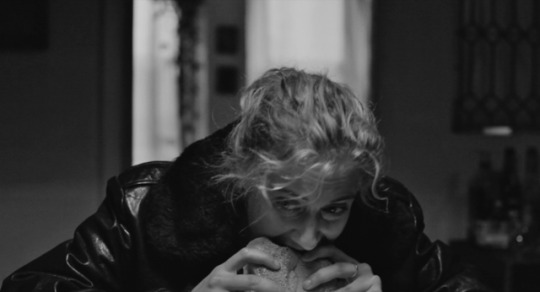
The cinematographic techniques evident in Frances Ha certainly take inspiration from À bout de souffle, as the manipulation of shots, editing, and sound are used in similar ways with the same goal of demonstrating to the audience how the cinematic medium can represent reality not objectively, but in the way that the protagonist experiences it. Moullet characterizes À bout de souffle as “a series of sketches, of interludes which at first sight have no connection with each other (…) But through their existence, these episodes have a strong connection with each other, like all life’s phenomena” (Graham and Vincendeau 223-224). This description could have been written about Frances Ha, whose title derives from the film’s final moment when protagonist Frances Halladay can only fit the letters “Frances Ha” on the label of the mailbox in the apartment she moves into. This serves as a fitting metaphor for the way in which both À bout de souffle and Frances Ha define life and reality by individual, often unremarkable moments. The jump-cut method in both films creates a snapshot quality, mimicking the way one lives life, experiencing dull moments and passing by important milestones. Frances Ha uses extreme jump-cuts, omitting major turning points like her moving from one apartment to another and elongating trivial ones like the long shot of her running around New York at night in search of an ATM instead of letting her date pay for their meal (Baumbach). The effect induced by this style is the humanization of Frances, and the depiction of a woman that is defined by the quirky and often banal happenings of her daily life, rather than by the male gaze as is the case with Patricia’s character is À bout de souffle.
2 notes
·
View notes
Text

Watching Marianne in Godard’s Pierrot le Fou, arguably the sole woman of substance in the film, I recalled the French words “coquette” and “coquine”. Used often interchangeably, the first means flirtatious and bold while the second induces the image of a more mischievous, conniving woman. This simultaneous dichotomy and harmony between “coquette” and “coquine” illustrates the female protagonist as endearing and appealing yet toxic and devious. Though this appears as an anti-feminist representation, Godard includes moments that expose Marianne’s agency, as she leads Ferdinand back into town after becoming terribly bored on the French Riviera, yelling “J’ai rien à faire” over and over down the beach.
0 notes
Text
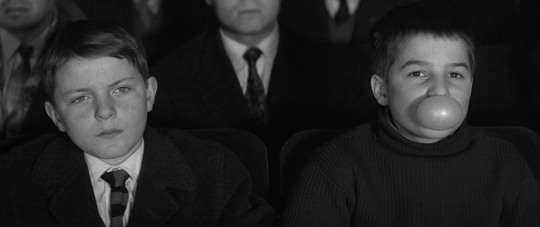
In Cahiers’ 1962 interview with Truffaut, the latter describes how in his movies Tirez sur le pianiste and Jules et Jim, he did not want his characters to be entirely sympathetic. When asked if he worried about this in The 400 Blows, he said, “I made the film in a very instinctive way. The subject predominated. Such and such a scene had to be seen through the eyes of the boy, and so had to be shot in a certain way (…) it was neutral; the direction was purely moral, self-effacing.” The idea of self-effacement is critical to the depiction of Antoine as a sympathetic character. Enabled by mise en scène, the self-effacement of the film, or perhaps more technically of the camera, allowed the audience to inhabit Antoine’s skin. His delinquent nature and frequent misfortunes throughout the film make him unsympathetic on paper, but one may contend that the cinematography allows the audience to relate to Antoine and render him sympathetic.
The final tracking shot seems to be the summation of Truffaut’s approach to cinema. The longevity of the shot proves that Truffaut is not inhibited by pre-established filmmaking conventions, and also refers to the technological advances made that allowed for lighter weight handheld cameras suitable for longer, more dynamic shots as this one. When the boy looks into the camera, and thus into the audience, at the very end, there is a shift in tone. Suddenly, the self-effacing cinematography is flipped and the audience is placed into an intimate, disconcerting position where this young boy appears to be looking for something: help, compassion, understanding. In conclusion, the fact that the last image is a freeze-frame adds an element of self-reference, alluding to the idea that the boy, along with the rest of the film, is only an image.
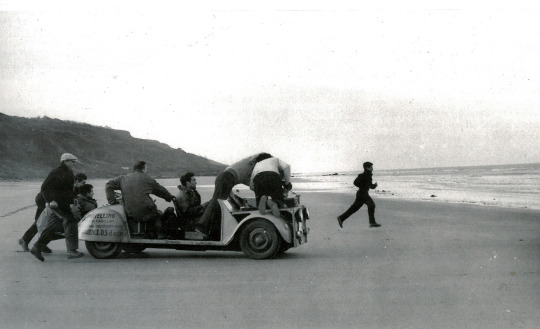
0 notes
Photo
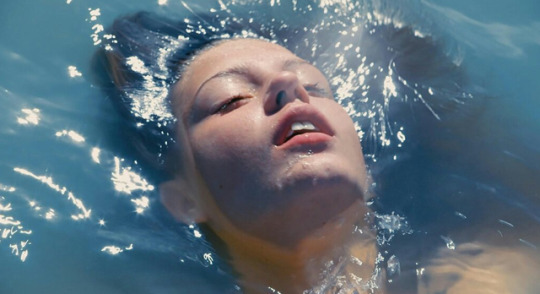
Desire in Blue is the Warmest Color is palpable, as Kechiche employs various cinematic techniques to demonstrate the indifference with which Adèle explores romance with a boy, and the passion she feels when she is with a woman. The omnipresence of the color blue, whether it be on the characters’ clothes, Emma’s hair, her lycée’s classroom walls, or the nail polish color worn by the first girl Adèle kissed, it is a constant reminder of Adèle’s secret desire (Kechiche). The English title Blue is the Warmest Color captures the idea that this desire is somehow wrong, and yet both Adèle and the audience are engulfed in the incredibly bright blues that pepper the screen as she becomes a woman and acts upon her true desire for Emma. The strong presence of primary blues echoes the way in which Godard approached using color in his films. In the Cahiers du cinéma interview with Godard “Let’s Talk About Pierrot”, the cineaste contends, “I wanted to show these elements but without necessarily placing them as they are in reality. Rather as they remain in the memory – splashes of red and green, flashes of yellow passing by. I wanted to recreate a sensation through the elements which constitute it” (235). Kechiche achieves the representation of blue in memory form, consciously removing the bright blue from Emma’s hair as the couple’s passion for each other dwindles.
0 notes
Text
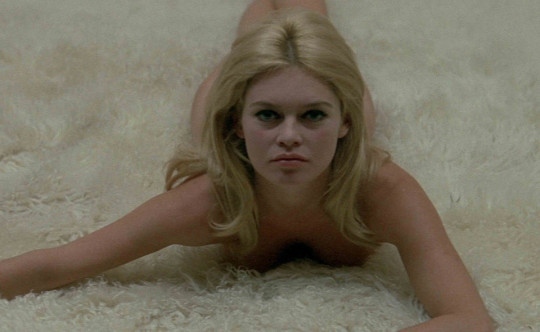
I think gratuity is integral to Godard’s films. Elements of the nude montage scene in Le mépris seem arbitrary. However, the presence of the Camille’s theme, the melancholic and nostalgic string melody, suggests this scene is critical in her evolution as a character. Camille’s phrase, “We used to live in a cloud of unawareness in delirious complicity”, at the beginning presents the scene as an analeptic reel, a glimpse into the couple’s loving past. Her repetition of the phrase at the end not only gives closure to the dreamlike montage and signals the return to actuality, but also confirms to the audience that Camille is no longer complicit in her relationship with Paul. In the next few scenes following the montage, the music is introduced erratically, appearing in moments of Camille’s doubt such as when she asks Paul what he would do if she were to stop loving him or when she talks with Prokosch on the phone. The strength of this music during the nude scene presents it as a turning point in the film, integral to the development of the plot and themes.
0 notes
Photo
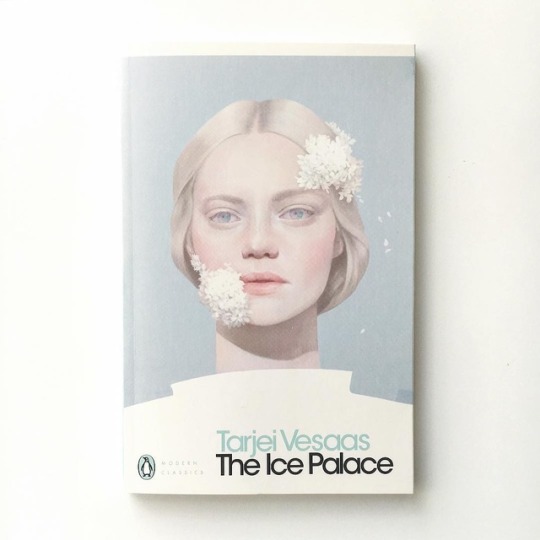

The clouds descend through the crevices of the mountains. Pachelbel’s Canon plays dramatically, signaling a moment worthy of ceremony. Not a single human in the shot, yet one sees Maria’s story unfolding as the clouds slowly form the Maloja Snake. No one witnesses the ice palace fall, either. The violent ruptures in its structure happen in silence. The ruins of the palace melt before the world knows it fell, yet we know it is in this moment that Siss has moved on.
The nature presented in both Clouds of Sils Maria and The Ice Palace follows its own subplot, seemingly adjacent to the central stories. Yet, the characters’ journeys are continually reflected in the nature described around them. The climaxes of the two stories described above are not scenes of human drama. Nature appears to express the emotions and turning points too grand, or perhaps too incomprehensible, to articulate in words. The themes of both works, including aging, sexuality, and loss, are left unresolved. This inexplicability is a universal part of the human condition, and it is arguably the untied ends of the themes that make them viscerally relatable.
A theme embedded in nature here is homosexuality, or the unexplained intimacy between the two female characters of the two plots. In The Ice Palace, the incredibly long scene in which Unn explores the ice palace alone is full of references to her relationship with Siss and her own solitude. As she walks through each room, she encounters one that she names “a room of tears” (Vesaas 52). In her eyes, the tears falling down the walls are water from the ice, dropping onto her coat from above. But then, the narrator states, “Suddenly she understood, now she could see it clearly: it had been herself, plunged in her own tears” (Vesaas 54). Here, the line between Unn’s inner thoughts and the anatomy of the ice palace is indistinguishable. This moment indicates that she is navigating the palace and her emotional state simultaneously. After calling out for Siss in the echoing rooms, she notices an “eye of ice”, and, confronting it, she says, “Here I am. I’ve been here all the time. I haven’t done anything” (Vesaas 58). The Gatsby-esque symbolism of the eye as society’s judgmental gaze is a subtle hint towards Unn’s homosexual urges. The way she asserts she has done nothing can be seen as both a denial of her nature and an acceptance of it as something valid. In the moments leading up to her death in the palace, she describes the “piercingly bright” light shining through the ice and the narrator says, “Not once did she think this was strange; it was just as it should be” (Vesaas 60). Unn’s childish perspective leaves gaping holes where the concepts and feelings that she is too young to understand would lie, yet manages to capture the raw, innocent truth of this moment. Her solitude, her infatuation with Siss, her perpendicularity to her classmates, all of which pertain to her closeted experience with Siss rise to the surface as she starts to die, yet the nature around her seems to assure her that the way she is is how it should be. While not openly celebrating divergence from heteronormativity, the story’s undertones certainly allude to it.
Nature in Clouds of Sils Maria is perhaps even more explicitly full of significance, as it is starkly contrasted with the superficiality of the film industry. In Maria and Val’s long hikes in the Alps, they are often filmed running lines for her upcoming play Maloja Snake. It is hard to tell where the characters’ lines in the play end and where those of Maria and Valentine begin. As in The Ice Palace, the process of getting lost in nature is recurrent throughout the film. From the dizzy scene in which Val becomes sick from driving through the winding mountain roads to the scene where Maria does not trust Val’s navigation as they try to catch a glimpse of the Maloja Snake, it seems that navigation is a constant within the pair’s dynamic. It is also relevant to the way their relationship develops as Maria attempts, and arguably fails, to orient herself within the role of Helena. They each take the play in opposite directions, Maria envious of Sigrid’s youth and haunted by the pathetic nature of Helena’s downfall, while Val tries to convince her that Helena is the one worthy of admiration embodying at once both innocence and maturity. Val’s unexplained disappearance therefore marks both a rupture in the depiction of their relationship and a natural twist in their paths. As they both descend into a valley out of shot, the audience is left with an image of peaceful, undisturbed nature, and then Maria slowly climbs up back into the shot, unaccompanied by Val. After questioning whether what she sees in the distance is the cloud formation they have been searching for, Maria suddenly becomes aware of Val’s absence. She calls out for Val as she walks back the way they came, never to see the magnificent Maloja Snake nor Val ever again. The long take of the clouds, conjuring up the loss and confusion of Wilhelm’s death at the beginning of the film, captures these feelings of losing one’s self in a way that Maria could not come to terms with in her role as Helena nor in her relationship with Val. Though nature here does not offer any resolution, it symbolizes the negative capability needed in the film to communicate the obscurity and confusion of Maria’s journey and her complicated intimacy with Val.
0 notes
Text
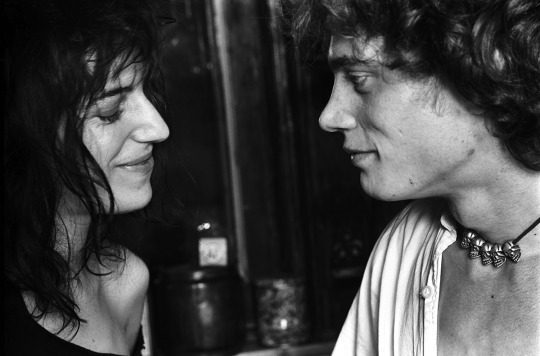
Patti Smith’s Just Kids captures the epicenter of art and grime that was New York in the 1970s. She centers the story upon the unorthodox girl she was in her twenties, and her predestined relationship with the late photographer Robert Mapplethorpe. The story Smith unfolds is a mesmerizing cluster of moments, each as brilliantly imaged as her cherished blue star. While her autobiographical account is rooted in the happenings of her intimate routine, the novel is read as a field guide to her version of the vast city. Yet, Smith disregards the objective city by blending the real and the otherworldly in her seamless streams of consciousness. The constant that threads together the contradiction of her city life is her love for Robert. Their relationship is celestial; they are two soulmates brought together almost divinely, and yet their closeness is physically distant and intertwined with the figures around them. Intimacy and multiplicity are figuratively mutually exclusive yet in practice interdependent in Smith’s depiction of New York.
The structure of Just Kids is artefactual, organized by a series of moments through which the reader is guided like an observer in a museum. Smith is a skillful curator, constructing her personal enclave within the larger city. One of these moments is Christmas at her and Robert’s first apartment:
“He liked the boxes of Joseph and often transformed significant bits of jetsam, colored string, paper lace, discarded rosaries, scrap, and pearls into a visual poem. He would stay awake late into the night, sewing, cutting, gluing, and then adding touches of gouache. When I awoke there would be a finished box for me, like a valentine. Robert made a wooden manger for the little lamb. He painted it white with a bleeding heart and we added sacred numbers entwining like vines. Spiritually beautiful, it served as our Christmas tree. We placed our gifts for one another around it.” (Smith 51-52) Smith illustrates moments palpably to craft their intimate world. She and Robert physicalize their isolation from the outside; the act of making their own original talismans mimics creating a new reality. Smith’s description of Robert fashioning the manger is almost ironic: it depicts him in reference to the stereotype of handy man of the house, constructing practical objects for his family. Their concept of practical or necessary, however, is unusual. Smith cherishes the manger painted with a “bleeding heart” and “sacred numbers”, despite having little functional furniture in their apartment. (51-52) The manger serving as a Christmas tree also holds meaning. The two Catholics are at once rejecting the tradition of the classic decorated tree and celebrating their own eccentric version of the popular holiday. Thus, Smith’s capture of this creative moment is both decidedly intimate yet still connected to the multiplicity of daily life.

These snapshots of creation may appear to some readers to trivialize her journey of self-discovery or render it superficial, but they do not. In broad terms, the moments she writes are the intricate pieces of the mosaic that is her perception of New York: each piece is different, entirely sustainable as a world of its own, yet fits perfectly within the grand scheme. Hence, Smith’s structure enables the formation of her intimate world but grounds it in the colorful context of the city, successfully interconnecting intimacy and multiplicity.
Furthermore, Smith’s novel entertains a duality between the real and the unreal. Her dichotomized place in New York is introduced in early stages of Smith and Robert’s relationship, as Smith describes:
“One Indian summer day we dressed in our favorite things (…) we took the subway to West Fourth Street and spent the afternoon in Washington Square. We shared coffee from a thermos, watching the stream of tourists, stoners, and folksingers. Agitated revolutionaries distributed anti-war leaflets. Chess players drew a crowd of their own. Everyone coexisted within the continuous drone of verbal diatribes, bongos, and barking dogs.” (Smith 47)
This scene offers an image rife with energy and movement in the public environment. Yet, while Smith speaks of coexistence, she refrains from placing herself into the context she defines. She serves only as the observer, sipping coffee with Mapplethorpe gazing onto the outside from within their transcendent experience, displaying an otherwise dynamic sequence as coldly as a still-life. It is only when an older couple comments on her and Robert’s roles that Smith closes their distance from their surroundings. The woman tells the accompanying man to take a picture of the two characters that seem like artists to her. “’Oh, go on,” he shrugged. They’re just kids.” (Smith 44) Significant enough to inspire the title, this encounter introduces the ideas of intimacy and multiplicity within Smith’s world and the city around her. As much as she and Robert seek to elevate and enchant their realities, they have become stereotypical, two of many inhabiting the city. They may present themselves as the personas associated with their alternative lifestyle, but ultimately Smith recognizes their commonality. In this way, she calls the distinction between intimacy and multiplicity into question, refusing to abandon one to obtain the other.
The line between real and unreal is rendered particularly nebulous in the context of the Chelsea Hotel.

“In between I clock the action. Eyeing the traffic circulating the lobby hung with bad art. Big invasive stuff unloaded on Stanley Bard in exchange for rent. The hotel is an energetic, desperate haven for scores of gifted hustling children from every rung of the ladder. Guitar bums and stoned-out beauties in Victorian dresses. Junkie poets, playwrights, broke-down filmmakers, and French actors. Everybody passing through here is somebody, if nobody in the outside world.” (Smith 91)
The graphic use of italics here visually signals a shift in Smith’s narrative. It underlines the dreamlike sequence that is Smith and Mapplethorpe’s experience at the Chelsea Hotel, distancing the people and happenings in the hotel from the urban exterior. The mention of “stoned out beauties in Victorian dresses” widens this distance by adding an epochal dimension to the hotel’s otherworldliness. (Smith 91) Lastly, the last sentence draws a boldly strict line between the hotel and the “outside world”. (Smith 91) Yet, the ideas of being “somebody” at the Chelsea and “nobody” in the vaster realm of Manhattan are inextricably linked. (Smith 91) Within the environment of the Chelsea, Smith belonged to a circle of drug-infused artists and patrons: society’s misfits bound together through shared estrangement. They had become somebodies amongst themselves evidently because they had all experienced the isolation of having been nobodies. Therefore, Smith underlines a causal relationship between the intimacy of the Chelsea Hotel and the inhabitants’ incongruence with New York city’s multiplicity.
Smith’s definition of intimacy is explored in distinct instances of Just Kids. It is a central theme to Smith and Mapplethorpe’s epic love story. It appears that their relationship guides the plot’s development, and hence mirrors Smith’s grander depiction of the city in terms of intimacy. From the moment they meet, Smith and Mapplethorpe are drawn to each other. Their initial encounters recall fairytale lovers who credit fate for their meeting. Disregarding courtship, they readily accept each other into their lives, as Smith states not long after their first meeting, “(...) I understood that in this small space of time we had mutually surrendered our loneliness and replaced it with trust”. (Smith 40) From this moment, much of Smith’s writing about their relationship is description of their routine. Painting and creating side by side was their ritual; in this way their daily lives were engulfed in the other’s. Despite this, Smith consciously refrains from including information that would define their relationship. While they were in love or perhaps they cared profoundly for the other, the lack of romantic intimacy conveyed alluded to the idea that their relationship was platonic. Smith’s ambiguous account of her and Robert’s bond calls intimacy into question, and perhaps deliberately pushes against its singular definition.
Multiplicity also plays a part in building Smith and Mapplethorpe’s intricate relationship. The number and diversity of figures they encounter allows them to create their intimate world away from reality. At the Hotel Chelsea, they meet an array of people including Mr. Bard, Harry Smith, Peggy Biderman, Ann Powell, Bruce Rudow, Sandy Daley, and Matthew Reich. Each person elicited a form of self-discovery for both Smith and Mapplethorpe. The introduction of these figures play an integral role in both of their artistic pursuits, and therefore reinforce their mutual creative inspiration for one and other. Thus, their intimacy is invigorated by the multiplicity of creative characters around them.
However, Smith and Mapplethorpe’s world undergoes growing tension throughout the novel. One instance in the novel that represents a striking turning point in their relationship occurs when Robert goes to an abandoned hospital and finds a fetus preserved in jar. Convinced he should transform the fetus into art, he steals the jar, but on their way home he inadvertently drops it. Smith describes the effect of this accident with the following citation:
“The purloined jar had sat on a shelf for decades, undisturbed. It was almost as if he had taken its life. 'Go upstairs,' he said. 'I'll clean it up.' We never mentioned it again. There was something about that jar. The shards of heavy glass seemed to foreshadow the deepening of our days; we didn’t speak of it but each of us seemed inflicted with a vague internal restlessness.” (Smith 69)
The jar appears to be a symbol that represents a tonal shift in Smith’s description of their relationship. Though Robert did not actually take the fetus’s life, Smith mentioning this represents birth and death simultaneously. The incident undoubtedly brought her own abortion and the trauma associated with it to mind. It could also be said that the scene underlines the limitations of Smith and Mapplethorpe’s nontraditional intimacy in terms of family-making. In this sense, the jar evokes the multiplicity within the intimacy, or the complexity that is the essence of Smith and Mapplethorpe’s feelings for each other, and for their perceptions of themselves. In fact, it is the very multiplicity within their relationship that eventually redraws its own confines. Thus, the “internal restlessness” Smith refers to foreshadows the increased strain on their world and the unease that accompanies these complexities. (69)
The themes of intimacy and multiplicity can be perceived to define not only the relationship between the two central characters of Just Kids, but also urban life itself. Manhattan is the singular backdrop for this story. This island, surrounded by water yet the heart of the world, is the essence of intimacy within multiplicity, of a patchwork of surface, sound, sight, scent, and taste. At any moment, this kaleidoscope of experience can collapse or delicately fold into the intimacy of a bedroom, a café table, a hospital bed. The structure of the book, the otherworldliness Smith references, and Robert and Patti’s complex relationship strengthen these interconnections between intimacy and multiplicity that are central to her New York story.
2 notes
·
View notes
Text

Reflecting upon Resnais’ Hiroshima mon amour, one image that stayed with me was the shot of the woman from Nevers alone in front of her hotel room, standing against the opposite wall with the light escaping from her room shining on to her in the dark hallway. After failed attempts at entering her room or even looking into it, she finally faces the light as she cries.
The scene had no dialogue, which may be way the images seemed unusually poignant. Light can be seen as a reference to the atomic bomb, and the blinding white light it produces when dropped. Her determined gaze into the light suggests an acceptance of the past: both hers in Nevers and that of Hiroshima.
The idea of collective memory remains malleable throughout the film. The phrase “to remember Hiroshima” is an oxymoron, as no one who experienced the event would be alive to recount it. This postulation questions the very notion of memory and experience. The doubt surrounding the aforementioned concepts blur the lines between what is present, analeptic, or proleptic within the narrative. Finally, the fact that the audience never know their real names, but only know them by “Nevers” and “Hiroshima” as they refer to each other at the end, epitomizes the belief that one is one’s past. In that way, memory in Hiroshima mon amour is the main source of characterization.

0 notes